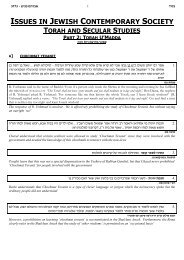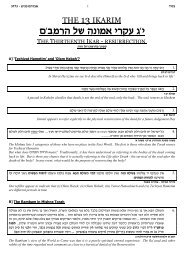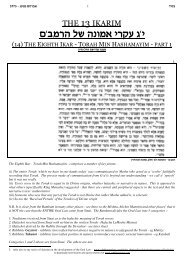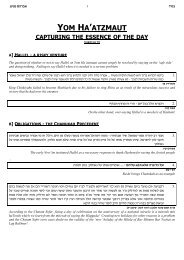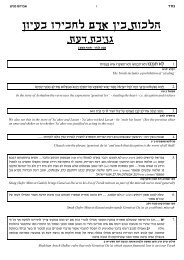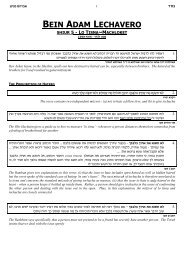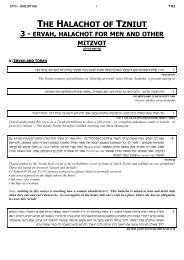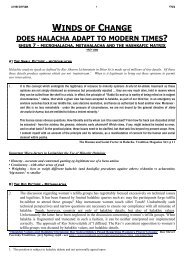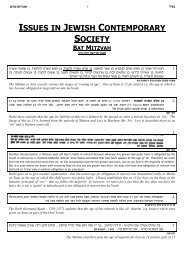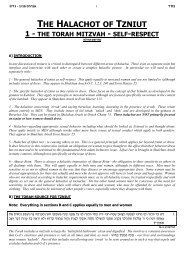Shiur 5 - Ikar 12 (Lander) - Rabbi Anthony Manning
Shiur 5 - Ikar 12 (Lander) - Rabbi Anthony Manning
Shiur 5 - Ikar 12 (Lander) - Rabbi Anthony Manning
You also want an ePaper? Increase the reach of your titles
YUMPU automatically turns print PDFs into web optimized ePapers that Google loves.
dbhbn ovrct<br />
1<br />
sxc<br />
THE 13 IKARIM<br />
ocnrv ka vbunt hreg dh<br />
5 - THE TWELFTH IKAR - MASHIACH<br />
cga, ;ruj - rsbk iufn<br />
A] The <strong>12</strong>th <strong>Ikar</strong><br />
tcha uk vfjt vz kf ot vnvn,ha pgtu jhanv ,thcc vnka vbuntc ihntn hbt<br />
1.<br />
ch ihntn hbt<br />
.e uk o «aUh tku '(d:c euecj) IºkvF©j V©n§v©n§,°ho¦t -rjth tku tcha ,ntku ihntvk tuvu /jhanv ,unh - rag ohbav suxhvu 2.<br />
'u,kusdc ihntvku /ihme hcajn ka i,gs jup, ohrnt ohnfjv /«utuc inz ivn thmuvk ,utrenv uarph tku 'cume<br />
czfn - urcs kzkzn ut epx uc khy¥na hnu /hftkn sgu vann thcb kf hsh kg uc rcªsa vn hpf 'uhkg vkp,vu u,cvtu<br />
vnka grznu 'susn tkt ktrahk lkn iht hf vzv suxhv kkfnu /ohcmb o,tu ogkc ,arpc aurpc uc v¨sgh rat vru,v<br />
uhthcb hrcscu wvc rpuf ,tzv vjpanv rcs kg ekuja hn kfu /sujhc<br />
ihrsvbx vban 'ekj pk vnsev - ocnr<br />
The essential elements of the <strong>12</strong>th <strong>Ikar</strong> are: (i) confidence that Mashiach will come; (ii) not trying to predict the actual<br />
date of his coming; (iii) appreciating the greatness of Mashiach and the era of Mashiach; (iv) davening for Mashiach; (v)<br />
that a Jewish king cannot be from any family other than that of David and Shlomo 1<br />
B] The Messianic Era -vs- Olam Haba<br />
UbUgh¦sIv rcF /(dh'zf ohkhv,) oh°H©j .¤r¤tC wv-cUyC ,It§rk 'h¦T±b©n¡t¤v tkUk r¨n¡t®B¤J 'tC©v okIg¨v h‾H©jk v²U©t§,¦v±u sh°u¨S V©n¨T v¨Nf±u z<br />
QUrC JIsË©v tk¥t V¨nmg±u V²hp²h±u Vk§s²D g¥sIh ih¥t±u 'V²h§rC kg V²dh¦¬©vk o¨sẗC ©jIF ih¥t tC©v okIg¨v ,cIY¤J oh°bIJt¦r¨v oh¦nf£j<br />
Qk¤N©v ,InhC k¥t¨r§G°h i¤vC ih°b§v°B¤J ';UDK¤J oh¦rc§sk tk¥t i²bh¥t 'k¥t¨r§G°hk oh¦thc±B©v i¤vC ih¦tC³b§,¦N¤J ,IcIY©v kF¤J±u `ISck tUv<br />
k¥t¨r§G°hk vk¨J§n¤N©v r«z§j©T¤J i¨n±zC '©jh¦J¨N©v<br />
r¥nIt Uv²hg©J±H¤J tUv /iIh§n¦SC V¨,It U,£jp°h t¤J h¥sF 'oh¦thc±B©v ¨vUN¦s tO±u 'iIh§n¦s±u Q¤rg Vk ih¥t 'tC©v okIg¨v h‾H©j ,cIy kc£t<br />
V¨,It v¨Gg tk¥t 'thc²b ihg V¨,It v¨,£t¨r t¤J vcIY©v r©nIkF (d'sx uvhgah) Ik-vF©j§nk 'v¤Gg³h--W§,kUz oh¦vO¡t 'v¨,ẗ¨r-tO i°hg"<br />
i°hg" 'tC©v okIg¨v kc£t '©jh¦J¨N©v ,Inhk tk¥t UtC³b§,°b tO iKF oh¦thc±B©v kF 'oh¦nf£j Ur§nẗ /Ik vF©j§N¤J o¨sẗk oh¦vO¡t¨v<br />
".W§,kUz oh¦vO¡t 'v¨,ẗ¨r-tO<br />
z:j vcua, ,ufkv o"cnr<br />
We have almost no understanding of the nature of Olam Haba. The prophecies in Tanach refer to Yemot HaMashiach,<br />
which is part of Olam Hazeh<br />
C] What is the Messianic Era<br />
/k¥t¨r§G°h h¥j§s°b .C©e§nU 'J¨S§e¦n v‾bIcU 'v²bIJt¦r¨v vk¨J§n¤N©v V²b§J²hk sh°u¨S ,hC ,Ufk©n rh°z§j©vkU 's«ngk sh¦,g ©jh¦J¨N©v Qk¤N©v t<br />
/v¨rITC v¨rUn£t¨v i¨,²um¦n kfF ,IkcIh±u ih¦Y¦n§J ih¦GIg±u ',IbC§rë ihch¦r§e©n :o¤s«E¦n Uh¨v¤JF 'uh¨n²hC oh¦yP§J¦N©v kF ih¦r±zIj±u<br />
h¥r£v¤J :UbC©r v¤J«ncU v¨rITC tk¥t 'rpIF tUv sckC oh¦thc±b rẗ§JC tO - I,ẗhck vF©j§n Ubh¥t§J h¦n It 'IC ih¦n£t©n Ubh¥t§J h¦n kf±u<br />
vm§eC 'W£j©S°b v®h§v°h-o¦t / / / oh¦Ng¨v-kF¦n WmC¦e±u 'c¨J±u `W¤n£j¦r±u 'W§,Uc§J-,¤t Wh¤vO¡t wv c¨J±u" r¨n¡t®B¤J 'uhkg v¨shg¥v v¨rIT<br />
o¤v 'v¨rITC oh¦J¨r«p§N©v oh¦rc§S©v UK¥t±u /(v-d'k ohrcs) "/ / / Wh¤vO¡t wv W£thc¡v®u /W¤jË°h 'o¨¦nU 'Wh¤vO¡t wv WmC©e±h 'o¨¦n--o°h¨n¨©v<br />
oh¦thc±B©v kF h¥s±h kg Ur§n§t®B¤J oh¦rc§S©v kF ohkkIF<br />
t vfkv th erp ohfkn ,ufkv o"cnr<br />
The Messianic Era for the Rambam involves: (i) restoration of the dynasty of David; (ii) re-building the Temple; (iii) the<br />
ingathering of exiles; (iv) the restoration of the halachic system to its full application<br />
3.<br />
4.<br />
1. Note the possbile anti-Christian message here since according to at least some Christian traditions, lineage was traced to King<br />
David through his son Natan
dbhbn ovrct<br />
2<br />
sxc<br />
D] The Non-Miraculous nature of the Messianic Era<br />
oh¦rc§sC tmIHf±u 'oh¦,¥n v®H©j§n It 'okIgC oh¦rc§S J¥S©j§nU 'oh¦,pInU ,I,It ,IGgk Qh¦rm '©jh¦J¨N©v Qk¤N©v¤J Q¨Tg©S kg vkg³h k©t d<br />
tc‾zIF icK¤J uhkF t¥GIb v²h¨v tUv±u 'v²h¨v v²b§J¦n h¥nf©j¥n kIs²D of¨j vch¦eg hC¦r h¥r£v¤J--iF rc¨S©v ih¥t `oh¦r§nIt oh¦JP¦Y©v¤J UK¥t<br />
i²uhF `,IbIugC d©r§v®B¤J sg '©jh¦J¨N©v Qk¤N©v tUv§J IrIS h¥nf©j kf±u tUv v¨N¦s±u /©jh¦J¨N©v Qk¤N©v tUv§J 'uhkg r¥nIt v²h¨v tUv±u 'Qk¤N©v<br />
/,pIn tO±u ,It tO 'oh¦nf£j UB¤N¦n Uk£t¨J tO±u '©jh¦J¨n Ubh¥t§J g©sIb 'd©r§v®B¤J<br />
tO±u 'i¤vhkg ihph¦xIn ih¥t±u 'oh¦nkIg h¥nkIgkU 'okIgk oh°B©T§J¦n ¨vh¤yP§J¦nU ¨vh¤Eªj ih¥t ,t«Z©v v¨rIT©v¤J :i¤v vfF 'oh¦rc§S©v r©ehg±u<br />
/xIrIehp£t³u g¨J¨r ht©S³UC v®z h¥r£v--iÿUJP¦n ,Ium¦NK¤J oh¦rc§S©v thmIv±u v¨rITC oh°bP vK°D¤J It 'g¥rID It ;h¦xIN©v kf±u `i¤v¥n ihg§rID<br />
5.<br />
c vfkv th erp ohfkn ,ufkv o"cnr<br />
Id¨v±b¦nF okIg tk¥t `,h¦Jt¥rC v¤Gg©nC JUS¦j o¨J v®h§v°h It 'okIgK¤J Id¨v±b¦N¦n rc¨S k¥yC°h '©jh¦J¨N©v ,InhC¤J cK©v kg vkg³h k©t t<br />
ihc§JIh k¥t¨r§G°h Uh§v°H¤J - rc¨S©v i³h±bg /v¨sh¦j±u k¨J¨n '(u:th uvhgah) ".C§r°h h¦s±D-og r¥n²b±u 'GcF-og c¥t±z r²d±u" v²hg©JhC r¨n¡t®B¤J v®z±u /QkIv<br />
oKF Ur±z§j³h±u /(u:v uvhnrh) "o¤vh¥rg-kg s¥e«J r¥n²b--o¥s§s¨J±h ,Ic¨rg c¥t±z" r¨n¡t®B¤J :r¥n²b±u c¥t±zC ohkUJ§N©v 'okIg¨v hg§J¦r og j©yck<br />
uvhgah `z'th uvhgah) "ic¤T-kft«h rëCF 'v‾h§r©t±u" r¨n¡t®B¤J 'k¥t¨r§G°hF ,©j³bC r¨TªN©v rc¨S Ukft«h tk¥t 'U,h¦j§J³h tO±u Uk«z±d°h tO±u ',¤n¡t¨v ,©sk<br />
'k¨J¨n Uh¨v rc¨S v®zh¥tk k«Fk g©s²U°h ©jh¦J¨N©v Qk¤N©v ,InhcU `o¤v ohk¨J§n '©jh¦J¨N©v i³h±bgC ihcU,F©v oh¦rc§S©v UK¥tC tmIHF kF if±u /(vf'vx<br />
i¤vC zUn¨r i²h±bg v©nU<br />
sckC ,IHfk©n sUCg¦J tk¥t '©jh¦J¨N©v ,Inhk v®Z©v okIg¨v ihC ih¥t 'oh¦nf£j Ur§nẗ c<br />
c-t vfkv ch erp ohfkn ,ufkv o"cnr<br />
The Rambam sees Yemot Hamashiach very much as part of this world - a non-miraculous continuation of our current<br />
existence, but ushering in an era of world peace. He emphasizes in particular that the halachic system will not change<br />
6.<br />
kf±u 'vC§r©v ,gP§Jªn v®h§v¦T vcIY©v¤J - ,Ur§j©,±u vẗ±b¦e tO±u v¨n¨jk¦n tO±u cg¨r tO o¨J v®h§v°h tO 'i¨n±Z©v I,ItcU v 7.<br />
rpgF ih°hUm§n oh°B©sg©N©v<br />
v vfkv ch erp ohfkn ,ufkv o"cnr<br />
The Messianic era will also one in which there is no world hunger. Taken together with the Rambam’s picture of a<br />
non-miraculous Messianic era, this is a pointed social comment on the cause of poverty and starvation today - not that<br />
there are insufficient resources to go around but that there is an unwillingness to share the resources that we have<br />
vbnn grdh tku vc ;xu,h tku 'v,kuz wv ,tn vru, tuc, tku 'kyc, tk van ,ru, ,tza tuvu /kuycv - hgha,v suxhu 8.<br />
ubnn grd, tku uhkg ;xu, tk rnt 'aurhpc tku cu,fc tk<br />
ihrsvbx vban 'ekj pk vnsev - ocnr<br />
The Rambam’s insistence on no fundamental changes in nature in the Messianic era is consistent with the 9th <strong>Ikar</strong> which<br />
requires that the Torah can never change. A fundamental shift in nature would require a fundamental shift in Torah.<br />
More critically, the Rambam’s first 3 <strong>Ikar</strong>im - proving G-d’s existence, his Unity and his Incorporeality - are based on<br />
rational and philosophical constructs which assume existence in the way that we have always understood it. If there is<br />
to be a seismic shift in the nature of reality, these 3 <strong>Ikar</strong>im may also be undermined and the Rambam’s proofs for G-d<br />
could disappear. For these reasons too, a non-changing reality in the Messianic Era is essential for the Rambam.<br />
trehu) vru,c cu,f tkvu t"t /s"ctrv ,dav /ivc uznr ihbg vnu 'kan vhv rcs vz htk kfk gsuh jhanv lknv ,unhcu ///// 9.<br />
/.rtv in vgr vhj h,cavu (u:uf<br />
t vfkv ch erp ohfkn ,ufkv o"cnr<br />
The Ra’avad objects that the Torah itself prophesies the change of animal nature in the Messianic Era, which presumably<br />
(as a verse in the Chumash, rather than Navi) cannot be interpreted as a mashal (or can it)<br />
vru, hanuj vanjf ,nhhe thv hrv r,xt ,khdnn .uj jhanv ,unhk kychk ihsh,g ohcu,fv kfu ohthcbv hrpx kf 10.<br />
,urmv ujfab hf (v"x uvhgah) rntba kych ,urmv iurfz kfa p"gtu 'okugk ihkyc ibhta vp kgca vru, ka ,ufkvfu<br />
tk orfzu ohsuvhv lu,n urcgh tk vktv ohrupv hnhu (wy r,xt) rntba ukych tk ohrupv hnh 'hbhgn ur,xb hfu ,ubuatrv<br />
kfn rpx kych tk hf 'vz tuv ,uyuhsv rcs t"t :kychk ihsh,g ohcu,fvu ohthcbv hrpx kf :s"ctrv ,dav /ogrzn ;uxh<br />
rucmc v,ut ,urekn kyc, tk vkhdn ovc ,urekn ohrpx rta ukych ukhpt urnt lf kct 'sunk uc ihta rpx ihta ohrpxv<br />
jh vfkv c erp vfubju vkhdn ,ufkv o"cnr<br />
The Rambam does however rule that the books of Nach will be abolished in the times of Mashiach. Interestingly, the<br />
Rava’ad here disagrees
dbhbn ovrct<br />
3<br />
sxc<br />
E] The Process of the Messianic Era<br />
VC Qkhk k¥t¨r§G°h kF ;«f²h±u 'vP kgC¤J±u c¨,fC¤J v¨rIT hpF 'uhcẗ sh°u¨sF ,Ium¦NC e¥xIg±u v¨rITC v®dIv sh°u¨S ,hC¦n Qk¤n s«ng³h o¦t±u s<br />
J¨S§e¦n v²bcU 'uhchc§X¤J ,INªt¨v kF jM°b±u '©jhkm¦v±u v¨Gg o¦t :©jh¦J¨n tUv§J ,©e±z¤jC v®z h¥r£v - wv ,In¨jk¦n o¥jK°h±u 'Vë§sC e³Z©jkU<br />
/ht©S³UC ©jh¦J¨n v®z h¥r£v -k¥t¨r§G°h h¥j§s°b .C¦e±u 'InIe§nC<br />
oh¦r¥JF©v oh¦nk§©v sh°u¨S ,hC hfk©n kfF tUv h¥r£v³u 'v¨rIT uhkg v¨jh¦yc¦v¤J v®z Ubh¥t§J gUs²HC - d©r§v®b It 'v«F sg ©jhkm¦v tO o¦t±u<br />
r¥rckU i¤vC ;Irmk 'Uk§JF°h ohkhF§G©N©v-i¦nU" r¨n¡t®B¤J 'ohC©r IC ,IX³bk tk¥t tUv QUrC JIsË©v Ish¦ng¦v tO±u /U,¥N¤J<br />
(vk:th kthhbs vtr) "sgINk 'sIg-hF :.¥e ,g-sg--iCkk±u<br />
iIz¨j sh¦ng©vk Ut§¬³B°h 'W§Ng hmh¦rP h‾bcU" r¨n¡t®B¤J 'kt‾H°b¨S IC tC³b§,°b rcF - ih¦S ,hcC d©r§v®b±u '©jh¦J¨n v®h§v°H¤J v¨N¦S¤J h¦rmIB©v gUJ‾h ;©t<br />
e‾Z©j§nU o¤vh¥j§s°b .C©e§nU 'ogh¦JInU k¥t¨r§G°h k¥tID ©jh¦J¨N©v¤J UrC¦S oh¦thc±B©v kF¤J :v®Z¦n kIs²D kIJf¦n J‾h hf±u /(sh:th kthhbs) "Uk¨Jf°b±u<br />
©VIk¡t s«cgk okIg¨v c«r ,Ig§y©vkU 'v¨rIT©v ;hk§j©vkU 'okhP§J©vkU o¨,h¦r¥t§J r³ZpkU 'c¤r¤jC k¥t¨r§G°h sC©tk o©r²D v®z±u `i¨,Ium¦n<br />
/wv h¥sgkC¦n<br />
s vfkv th erp ohfkn ,ufkv o"cnr<br />
s«ng³h 'dId¨nU dId ,¤n¤jk¦n o¤s«E¤J±u `dId¨nU dId ,¤n¤jk¦n v®h§v¦T ©jh¦J¨N©v ,In±h ,K¦j§,C¤J 'oh¦thc±B©v h¥rc¦sK¤J iÿUJP¦n v¤t¨r‾h ///////// c<br />
t¥N©yk tO tC Ubh¥t±u /(df:d hftkn) "thc²B©v v²Hk¥t ,¥t 'ofk ©jk«J hf«bẗ v‾B¦v" r¨n¡t®B¤J :oCk ihf¨vkU k¥t¨r§G°h r©³hk k¥t¨r§G°hk thc²b<br />
oIk¨J oUGk tk¥t `ihkUxP Ue±z§jªv¤J h¦n rh¦Jf©vk tO±u ',Ur§JF ,©e±z¤jC o¤v§J oh¦J²b£t k«xpk tO±u 't¥nŸ©v r©v©yk tO±u 'rIvŸ©v<br />
/(sf:d hftkn) "oh°bC-kg ,Icẗ-ck ch¦J¥v±u" r¨n¡t®B¤J 'okIgC<br />
'Uh§v°h Q©th¥v o¨sẗ g©s‾h tO - i¤vC tmIHf±u oh¦rc§S©v UK¥t kf±u /Uv²Hk¥t tIc²h '©jh¦J¨N©v Qk¤N©v ,©thC o¤s«E¤J oh¦r§nIt¤J oh¦nf£j©v i¦n J‾h±u<br />
QFhpkU `oh¦eUxP©v g©rf¤v hpk tk¥t 'UK¥t oh¦rc§sC vkC©e o¤vk ih¥t oh¦nf£j©v o³D /oh¦thc±B©v km¥t i¤v oh¦nU,§x oh¦rc§S¤J :Uh§v°H¤J sg<br />
/,¨SC rëhg 'iëUS§e¦S tO±u UK¥t oh¦rc§S ,³h²u£v rUS¦x ih¥t 'oh°bP kF kg±u /UK¥t oh¦rc§sC ,¤eO§j©n o¤vk J‾h<br />
- rëhg o¥nh¦G±h tO±u `i¤vC tmIHf±u UK¥t oh°b²h±bgC oh¦rUn£t¨v ,IJ¨r§s¦n h¥rc¦sC Qh¦r£t³h tO±u ',Is²D©v©v h¥rc¦sC o¨sẗ e©Xg§,°h tO okIgkU<br />
vF©j±h tk¥t /ihM¦e hc§©j§nK¤J i¨Tg©S ©jUp¨T 'oh¦nf£j Ur§nẗ `ihM¦E©v c©©j±h tO if±u /vẗ§r°h h¥shk tO±u 'vc£v©t h¥shk tO ih¦thc§n i²bh¥t§J<br />
/Ub§r©tC¤J InF 'rc¨S©v kkfC ih¦n£t³h±u<br />
c vfkv ch erp ohfkn ,ufkv o"cnr<br />
The Rambam rules that we have a outline understanding of the nature of the Messianic process but we have no clear<br />
tradition as to the details. Indeed, even Chazal were trying to work out the issues from the verses in Tanach, rather than<br />
from a mesora. As such, we should NOT be focussed on the details - who, how, when - but rather the general concepts<br />
11.<br />
<strong>12</strong>.<br />
.rtc vz tvha htb,cu 'atr uvuagha rnukf vchahc aht ,ubnk ohnfjvu ohshnk,v kfn vnfxv vhv, ota rucx hbtu 13.<br />
tk ota hpk /vmrha hn ,t lf rjt tuv lunxhu lunx vhvhu vchahv uk ohhe,, ahtv u,ut hrv 'ubnseva unf ktrah<br />
rcf hrvu epx hkc lunx tvha ovn sjt kf lhrma hpk 'okugk kusdv ihs ,hc ,uthmn ,hrapt tv, tk if rnt,<br />
hrv 'ihfunx obhta hp kg ;tu o,ut vbnh jhanva rnt, tnau 'vbuatrcf lhypua vchatu urntc o,chac wv jhycv<br />
vru,c tku c,fca vru,c tk vbnn grdh tku vru,c ;hxuh tk jhanva vz ubhrpx ,nsevc ubrthc rcfa hpk 'ajfun vz<br />
lhmguhu vbuatrcf lhypua vchatu rnt uhbnhxn vhvh vzu jhanv ,ukd,v hbpk cua, ihrsvbxva rucx hbtu /vp kgca<br />
ksd,u cuyv vagnc ucrhu ost hbc ,uck wv rhafh ratf epx hkc vhvh vzu 'esmv rhg lk treh if hrjtu vkj,cf<br />
trenv heuxpc rtc,ba unf jhanv tuc hbpk orah vcr,hu u,ru,ku wvk o,eua,<br />
d vban t erp ihrsvbx ,fxn vban kg o"cnr<br />
In his commentary on the Mishna, the Rambam describes the process for the reinstitution of the Sanhedrin and sees this<br />
as one of the signs of the imminent coming of Mashiach<br />
/vkt ,kuzu 'lhvkt wv knu /lhvkt wv cau 'ohnav vmec ljsb vhvh ot vru,c arupn 'jhanv ,thc ghsuv vana hpk ///// 14.<br />
u,uta oghsuvu 'uvhkt tuvu okugv ,t uhbpk rhafh aht uhbpk tchau 'uhnrudu uhbpk oseha vnc wv oac oghsuv ifu<br />
vru,c grdh tku ;hxuh tk ahtv<br />
z vban j erp ,uhusg ,fxn vban kg o"cnr<br />
Here, unlike his position in the MT, the Rambam describes the definite coming of Eliyahu as a precursor of Mashiach
dbhbn ovrct<br />
4<br />
sxc<br />
15.<br />
2 Maimonides Introduction to Perek Helek<br />
F] The Purpose of the Messianic Era<br />
i¤vk ,©j³B©n V²bh¥t§J vg§J¦r¨v ,Ufk©N¦n UjUb²H¤J h¥sF '©jh¦J¨N©v Qk¤N©v ,In±h o¤vh¥nf©j±u o¤vh¥thc±b k¥t¨r§G°h kF UU©t§,¦v v®z h‾bP¦nU c<br />
/tC©v okIg¨v h‾H©jk UF±z°H¤J h¥sF 'v¨nf¨jC UC§r³h±u gID§r©n i¤vk Utm§n°h±u 'i®d«vF ,Ium¦NcU v¨rITC e«xgk k¥t¨r§G°hk<br />
16.<br />
Us§Nk±h tO±u" r¨n¡t®b±u '(y'th uvhgah) "wv-,¤t vg¥S '.¤rẗ¨v vẗk¨n-hF" r¨n¡t®B¤J - ,¤n¡t¨v±u v¨nf¨j©v±u vg¥S©v vc§r¦T oh¦n²H©v i¨,ItC¤J hpk<br />
Qk¤N©v I,It¤J h‾bP¦n /(uf'uk ktezjh) "of§r©GC¦n 'ic¤t¨v ck-,¤t h¦,«r¦x£v³u" r¨n¡t®b±u '(dk'tk uvhnrh) "uh¦jẗ-,¤t Jh¦t±u Uvg¥r-,¤t Jh¦t 'sIg<br />
Q¤r¤S o¨,It v¤rIh±u og¨v kF s©Nk±h QFhpkU `UbC©r v¤J«N¦n cIrë tUv kIs²D thc²b±u 'v«nO§¦n r¥,²h v®h§v°h v¨nf¨j kgC sh°u¨S g©r®Z¦n s«ng³H¤J<br />
/(c'c uvhgah) "oh¦r¨v¤v Jt«rC wv-,hC r©v v®h§v°h iIf²b 'oh¦n²H©v ,h¦r£j©tC v²h¨v±u" r¨n¡t®B¤J 'Ig§n¨Jk oh°hID©v kF UtIc²h±u 'wv<br />
v®Z©v okIg¨v tUv ©jh¦J¨N©v ,In±h kc£t `tC©v okIg¨v h‾H©j tUv 'iIg¨r‾D tO±u e¥xp¤v Vk ih¥t§J v²bIr£j©t¨v vcIY©v±u IKF rf¨¬©v ;Ix±u<br />
tk¥t ©jh¦J¨N©v ,Inhk v®Z©v okIg¨v ihC ih¥t 'oh°bIJt¦r¨v oh¦nf£j Ur§nẗ rcfU /k¥t¨r§G°hk r«z§j©T ,Ufk©N©v¤J tk¥t 'QkIv Id¨v±b¦nF okIg±u<br />
/sckC ,IHfk©n sUCg¦J<br />
c:y vcua, ,ufkv o"cnr<br />
o¨,It Ut§¬³b±H¤J h¥sF tO±u 'oh°hIDC Us§r°H¤J h¥sF tO±u 'okIg¨v kF kg Uyk§J°H¤J h¥sF tO - ©jh¦J¨N©v ,In±h oh¦nf£j©v±u oh¦thc±B©v UU©t§,°b tO s<br />
h‾H©jk UF±z°H¤J h¥sF 'k¥Yc§nU G‾dIb o¤vk v®h§v°h tO±u 'V¨,¨nf¨j±u v¨rITC ih°hUbP Uh§v°H¤J h¥sF tk¥t :©j«n§Gk±u ,IT§Jk±u k«f¡tk h¥sF tO±u 'oh¦Ng¨v<br />
/vcUJ§T ,IFk¦vC Ub§r©tC¤J InF 'tC©v okIg¨v<br />
17.<br />
2. translation taken from With Perfect Faith - R. J David Bleich
dbhbn ovrct<br />
5<br />
sxc<br />
oh°B©sg©N©v kf±u 'vC§r©v ,gP§Jªn v®h§v¦T vcIY©v¤J - ,Ur§j©,±u vẗ±b¦e tO±u v¨n¨jk¦n tO±u cg¨r tO o¨J v®h§v°h tO 'i¨n±Z©v I,ItcUv<br />
oh¦nU,§X©v oh¦rc§S ohg§sIh±u 'ohkIs±D oh¦nf£j Uh§v°h QFhpkU /sckC wv ,¤t ,g©sk tk¥t 'okIg¨v kF eẍg v®h§v°h tO±u /rpgF ih°hUm§n<br />
(y'th uvhgah) "oh¦Xf§n o²Hk 'o°h©NF 'wv-,¤t vg¥S '.¤rẗ¨v vẗk¨n-hF" r¨n¡t®B¤J 'o¨sẗ¨v ©jIF hpF oẗ§rIC ,g©S Udh¦¬³h±u `oh¦eUng¨v<br />
v-s vfkv ch erp ohfkn ,ufkv o"cnr<br />
G] The Rambam and Yeridat Hadorot 3 18.<br />
'ohrunjf ubt - ohabt hbc ohbuatr otu 'ohabt hbc ubt - ohftkn hbc ohbuatr ot :tbunhz rc tcr rnt trhz hcr rnt<br />
ohrunj rtaf tkt 'rhth ic xjbp hcr kau txus ic tbhbj hcr ka urunjf tku<br />
:che ,ca<br />
ohbuatr /,heshx yjn ceb tknf ubtu - kfhv ka uj,pf ohburjt kau 'okut ka uj,pf ohbuatr ka ick :ibjuh hcr rnt<br />
/hchrc thgaut hcr - ohburjt 'guna ic rzgkt hcr - ohbuatr :hrnts tfht /guna ic rzgkt hcr - ohburjt 'tcheg hcr -<br />
,heshx yjn ceb tknf ubtu<br />
19.<br />
/db ihcurhg<br />
,umn :urnt 'vumn oak ihbuuf,n ihta uhafgu 'vmhkj ,umnk ,nsue ouch ,umn - vumn oak ihbuuf,n uhva vbuatrc 20.<br />
rc injb cr k"t /vmhkj ,umnk ,nsue ouch ,umn :rnuk urzj 'ejmh r"t tnj rc hnr rnt /ouch ,umnk ,nsue vmhkj<br />
!hrs ruaft :ejmh<br />
:yk ,unch<br />
All of these sources present a vision in Chazal of declining generations<br />
21. Because Rebbi saw such diversity in the teachings of our Sages, even though they all shared the same<br />
underlying principles, he feared that these teachings would not endure and proliferate, and loss would ensue.<br />
He saw that the heart was diminishing, the wellsprings of wisdom were being blocked up and the Torah was<br />
disappearing - vru, tek,xnu vnfjv ihgn o,xn teu tck ygnn<br />
As R. Yochanan says in Eruvin (53a) “The hearts of the early ones are like the entrance to the Ulam but the<br />
hearts of the later ones are like the entrance to the Heichal. Who are the earlier ones R Akiva. Who are the<br />
later ones R. Elazar ben Shammua”<br />
Iggeret Rav Sherira Gaon Ch 2 4<br />
22. However when the Mishna was concluded, and Rebbi died, the capacity for learning lessened and they had to<br />
collate their various Talmuds to recite it in a uniform version... They also included in their Talmud some things<br />
which had been unnecessary for the earlier sages ..... Those earlier sages whose capacity for learning was great<br />
had not needed to have these concepts explained. But after the earlier sages, wisdom decreased, as we learn at<br />
the end of Sota - “.... Since R. Akiva died the ... wellsprings of Torah have been blocked”. This same situation<br />
existed also in the days of Rebbi.<br />
5 Iggeret Rav Sherira Gaon Ch 6<br />
23. Along came the next generation and the heart became diminished. Certain matters had been clear to the earlier<br />
sages .... Now in this generation these matters became subject to doubt and they had to establish them in the<br />
Gemara with an exact wording ..... In each succeeding generation the heart became diminished, as R. Yochanan<br />
said in Eruvin (53a) “And our generation is like the eye of a fine needle”. Abbaye said “And we are like a peg in<br />
the wall with regard to Gemara”. Rava said “We are like a finger in wax as regards logic.” R. Ashi said: “We are<br />
like a finger in a pit as regards forgetfulness”<br />
Iggeret Rav Sherira Gaon Ch 7 6<br />
This concept has been adopted by various Rishonim (in particular Rav Sherira Gaon and Rashi) and is now accepted<br />
(assumed) by many as a fundamental Jewish idea. But how does it square with the Rambam’s non-miraculous<br />
Messianic Era<br />
3. For a full exposition see Maimonides on the “Decline of Generations” - Kellner (SUNY 1996)<br />
4. English translation of R. Nosson Dovid <strong>Rabbi</strong>nowich p16<br />
5. ibid p58<br />
6. ibid p 73
dbhbn ovrct<br />
6<br />
sxc<br />
21.<br />
Maimonides’ Introduction to the Mishna<br />
Rambam does NOT reject the approach of Chazal on the decrease of wisdom over time - see here from the Introduction<br />
to the Mishna<br />
rntnv ,bhjc h,kc osea hn rntnk unhfxvc kct ubhbgc rntnv ubjch tk hf vz ubbnzc ,ukudxv cur kfa uvz hf 22.<br />
!iunvv ifa kfu /osuev<br />
vnsev o"cnrk ,uumnv rpx<br />
Here in the Introduction to Sefer Hamitzvot, the Rambam bemoans the lack of intellectual ability of the <strong>Rabbi</strong>s of his time<br />
ohaurhpv o,ut lfhpk /vr,xb ubhbucb ,bhcu ubhnfj ,nfj vsctu kfv ,t vgav vejsu ,urh,h ,urmv upe, vzv inzcu 23.<br />
/rpxnc ygn tkt hutrf ovhbhbg ihcn ihtu ubhnhc uae,b ohrtucn ohrcs ova utru ohbutdv urcja ,ucua,vu ,ufkvvu<br />
inzu vnfj apbu vcjr ,gs ihfhrm ova t,pxu,vu hrpxu trpxu ,hnkaurhvu ,hkccv vnmg trndv rnuk lhrm ihtu<br />
/tuv lthv vru,v hbhs rtau ohr,unvu ohruxtv ohrcsc vjufbv lrsv ovn gsuh lf rjtu lurt<br />
o"cnrk vezjv shk vnsev<br />
However in the Introduction to the Mishne Torah, he gives a reason for this decline - the exile and accompanying<br />
political and social disruption<br />
24. I am one of the humblest scholars of Spain whose prestige is low in exile. I am always dedicated to my duties,<br />
but have not attained the learning of my forbears, for evil days and hard times have overtaken us and we have<br />
not lived in tranquility; we have laboured without finding rest. How can the Law become lucid to a fugitive from<br />
city to city, from country to country!<br />
Maimonides’ Letter to Yemen<br />
The Rambam sees the decline in the generations, not as an inherent and inevitable process, but as a result of social and<br />
political realities. When these realities change in the run up to Mashiach, the generations can once again rise to the<br />
level needed to merit the Messianic Era



